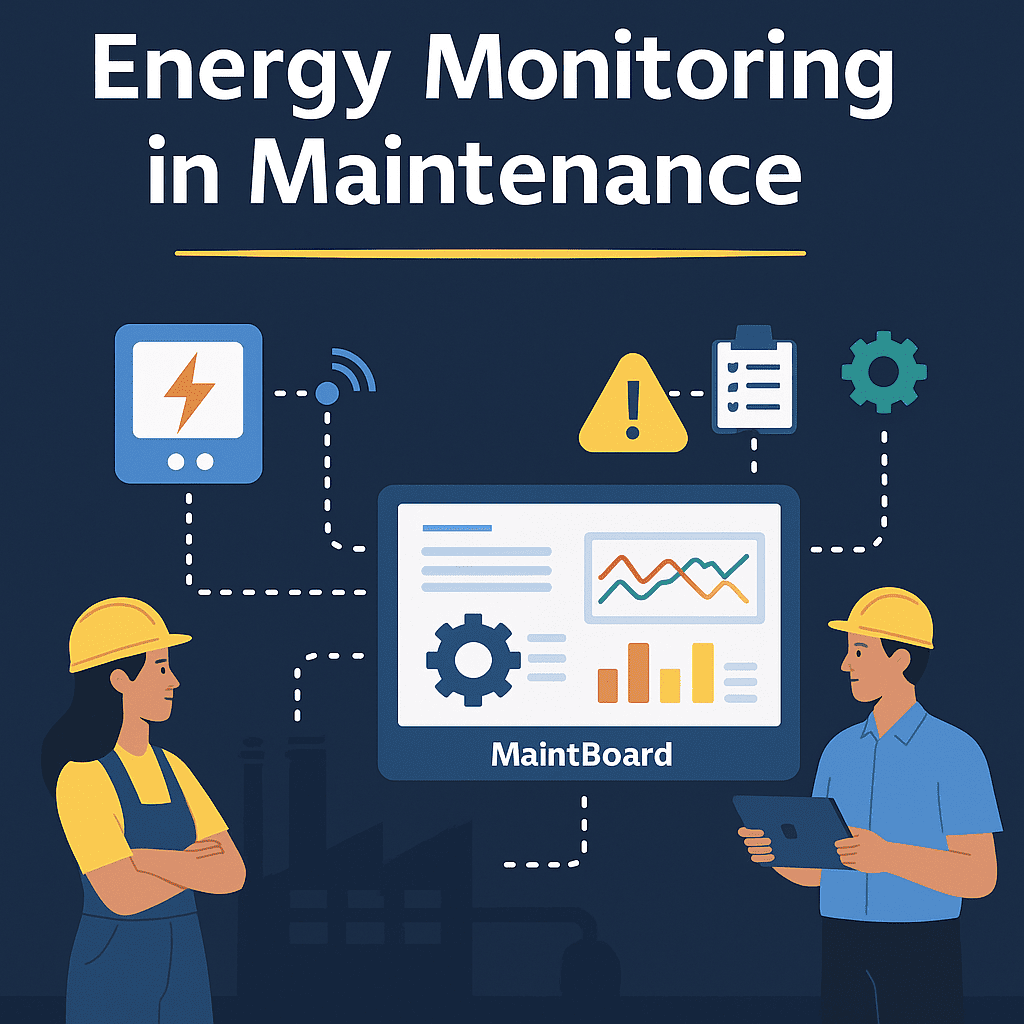The Ultimate Guide to Energy Monitoring in Maintenance for 2025

Introduction
In 2025, energy efficiency is no longer a side benefit—it’s a maintenance priority.
With rising utility costs, stricter environmental regulations, and increased pressure to optimize operations, maintenance teams must now lead the charge in tracking and reducing energy consumption.
That’s where energy monitoring in maintenance comes in. This guide explains what it is, why it matters, and how you can use it to improve asset performance, cut costs, and support sustainability goals.
What Is Energy Monitoring in Maintenance?
Energy monitoring involves tracking real-time and historical energy usage data from equipment and systems within your plant. It enables maintenance teams to:
- Detect anomalies before failure
- Trigger condition-based PMs
- Benchmark asset efficiency
- Link energy patterns to downtime or breakdowns
It turns energy from a hidden cost into a measurable performance signal.
Why Energy Monitoring Is a Maintenance Function
Traditionally handled by facilities or energy managers, energy oversight now overlaps heavily with maintenance because:
- 80% of energy waste is tied to underperforming or poorly maintained assets
- Maintenance teams control asset uptime, lubrication, alignment, and calibration
- Most breakdowns show early energy deviations (e.g., rising kWh or amps)
If you’re responsible for uptime, you’re now responsible for energy performance, too.
Benefits of Energy Monitoring for Maintenance Teams
- Detect wear-and-tear before physical symptoms appear
- Create PM schedules based on energy thresholds
- Reduce idle consumption with automation
- Support sustainability and ESG goals
- Justify maintenance budgets with energy savings data
How Energy Monitoring Works
- Energy meters or IoT sensors collect voltage, current, temperature, pressure, etc.
- Middleware (Node-RED, Kepware, etc.) cleans and routes data
- CMMS (like MaintBoard) receives that data via API/webhook
- Data is displayed in dashboards or triggers alerts/work orders
The integration empowers you to act on energy signals instantly.
Core Technologies Involved
- Meters: kWh, thermal, air, gas, vibration
- Protocols: Modbus, MQTT, OPC UA, BACnet
- Software: SCADA, CMMS, energy dashboards
- Devices: Edge gateways, PLCs, IoT modules
Use Cases and Examples
1. Overloaded Motor Alert
A motor begins drawing 18% more current than its typical load.
MaintBoard detects the deviation and auto-generates a work order to inspect alignment and lubrication.
Early intervention prevents overheating and unplanned downtime.
2. Compressed Air Leak Detection
Energy data shows a drop in pressure but rising kWh use during idle hours.
Leak confirmed via ultrasonic test, and the repair saves ₹1.2 lakh in annual energy costs.
The incident is logged in asset history for tracking.
3. HVAC Energy Spike Before Filter Failure
A chiller shows a 25% energy spike compared to historical average.
The root cause: clogged condenser coils.
PM frequency is adjusted based on seasonal energy patterns.
4. Pump Operating in Cavitation Zone
Energy meter data indicates fluctuating power consumption and rising temperature.
MaintBoard links this anomaly to an operational alarm.
A maintenance check reveals partially closed suction valves.
5. Idle Consumption Reduction
After an audit, a conveyor line is found to draw 3.5 kWh per shift even when not in use.
MaintBoard adds a logic rule: auto-shutdown after 10 mins of inactivity.
₹30,000 saved annually from just one system.
Cost of Implementing Energy Monitoring
- Hardware: Energy meters, IoT sensors, gateways
- Software: CMMS integration (like MaintBoard), middleware platforms
- Labor: Initial configuration, ongoing support
- ROI Timeline: Typically within 6–18 months depending on plant size and baseline waste
Even a single underperforming HVAC unit or pump can justify the investment through reduced energy bills and fewer repairs.
Security Considerations
- Use encrypted data transmission (HTTPS, MQTT-TLS)
- Segment industrial networks from IT systems
- Implement access controls and regular audits
- Monitor API and device activity through your CMMS or firewall
MaintBoard follows industry best practices for secure API integration and access control.
Strategic Advantages of Energy Monitoring
- Energy savings translate directly into budget flexibility
- Asset performance data improves reliability-focused planning
- Reduces ESG reporting burden with automated energy logs
- Gives maintenance a strategic voice in corporate energy discussions
The Future of Energy Monitoring in Maintenance
- AI-driven CMMS will detect energy anomalies and suggest repairs
- Energy benchmarking will influence procurement and capital planning
- Maintenance goals will include energy reduction targets
- Integrated energy-maintenance dashboards will guide plant optimization
MaintBoard and Energy Monitoring
MaintBoard supports:
- Meter integration via open APIs
- Energy KPIs on dashboards
- Triggered work orders based on consumption spikes
- Energy audit templates
- Cross-asset benchmarking
It’s the CMMS built for energy-aware maintenance teams.
Related Reading (Child Articles)
- How to Integrate Energy Meters with Your CMMS
- Energy KPI Maintenance: 7 Metrics to Track
- Energy Audit Checklist for Preventive Maintenance
- Downtime Energy Consumption: 5 Ways It Impacts Your KPIs and Costs
- 5 Energy Monitoring Mistakes Industrial Plants Must Avoid
- Top 5 IoT Energy Meters Factories Can Use to Slash Energy Waste
These articles give you tactical steps to apply everything covered here.
FAQ: Energy Monitoring in Maintenance
Does this require new infrastructure?
Not always. Many older meters can be upgraded with IoT adapters or integrated via middleware.
What kind of team do I need?
A cross-functional setup: maintenance, energy/facility engineer, and IT/OT support.
Can small plants benefit too?
Yes. Even one compressor or HVAC unit wasting energy adds up over time.
Conclusion: Own Your Plant’s Energy Story
Energy monitoring turns maintenance into a strategic lever for cost control, sustainability, and operational excellence. It’s not just about saving electricity—it’s about unlocking hidden insights from every machine on your floor.
Start with 1–2 high-consumption assets. Track. Measure. Adjust. Then scale plant-wide.
MaintBoard is here to support you every step of the way.
Talk to us or book a walkthrough to see how energy-first maintenance works in action.
This guide is created in line with Google’s helpful content guidelines and designed for maintenance managers, facility heads, and energy-focused operations teams.
